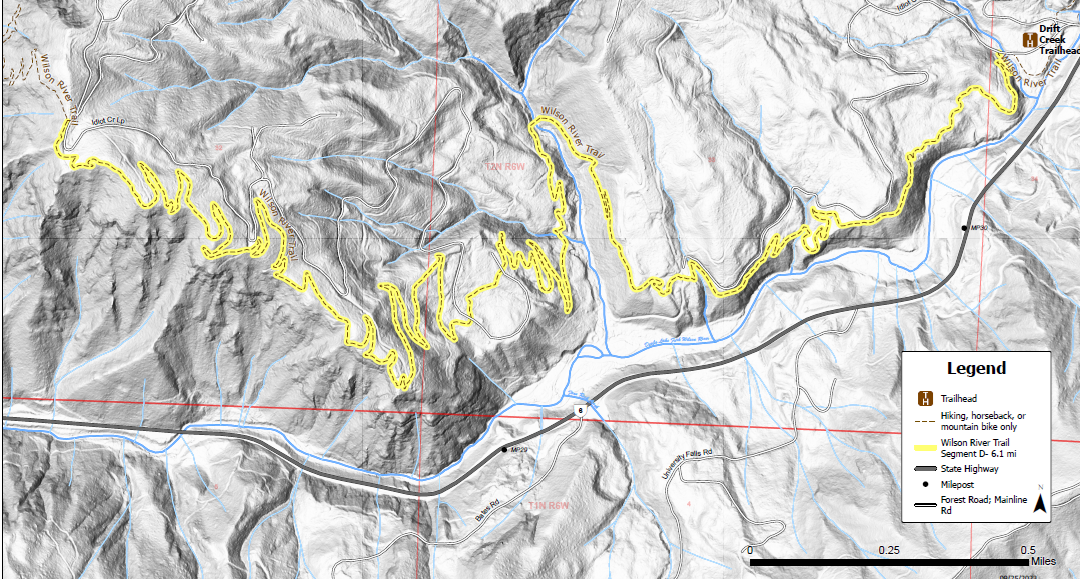New Opportunities Coming On The Wilson River Trail
The Wilson River Trail travels along a major river corridor in the Tillamook State Forest on the Coast Range. Construction first began in 1998 and 1999, connecting a mix of old logging roads, user trails, and fishermen’s access routes. Volunteer and professional crews shaped the 24.3 trail that today is a gateway for hiking, angling, mountain biking, camping, foraging, and picnicking. A short drive from Portland, it offers fantastic views, lush landscapes, and miles of trails for diverse use. Here, there is something for everyone!
Randy Peterson, the retiring Recreation Program Manager for the Oregon Department of Forestry (ODF), calls it a hidden gem. His dream is for the trail to span the entire Tillamook State Forest.
This dream is closer to reality thanks to donors to the State Forest Trust of Oregon. Their support is extending the trail by six miles, from Idiot Creek Loop Road to Drift Creek Trailhead (see map above), offering non-motorized users an easy-to-moderate trail with stunning creek and forest vistas further from the noise and bustle of Hwy 6. Completion is expected by October 2024.
Among those helping build this new section are the volunteers of Trailkeepers of Oregon (TKO). On the steep slopes of the mountain, volunteers have helped remove brush and logs prior to trail creation by youth crews from Ant Farm Youth Services and Northwest Youth Corps.
Joe Offer, ODF’s incoming Recreation Program Manager, shares, “This section will be quite unique from the rest of the trail. It will cross a different ecological zone so that visitors will get breathtaking views of the forest and mountains.”
If you’d like to support the expansion of the Wilson River Trail, visit Trailkeepers of Oregon to find out about volunteer opportunities or make a gift to State Forests Trust of Oregon’s Recreation Fund.
What Does It Take To Build A Trail?
Beyond a vision and a good amount of sweat, what does it take to build a trail? Well, to begin with, it takes time, planning, and support from the community of people who enjoy a variety of activities in our state forests.
Below is an overview of the steps ODF takes to build a trail on state forests, and each can take many months. Some phases may occur at the same time, but some may need to be repeated many times, such as finding contractors or public comment. Read more about the process below.
The above illustration is adapted from Oregon Trails Coalition’s introductory guide to trail planning and development, “Ready, Set, Plan!?”.
Proposal: Even the greatest idea needs to be presented in a clear proposal and that requires research and many conversations with internal and externa partners.
Feasibility: ODF will engage an interdisciplinary team to review proposed project. In some cases the project may require a NEPA (National Environmental Policy Act) Review.
Funding: Funds are needed for nearly every step along the way - feasibility studies, planning and design, public engagement, as well construction / implementation. In addition to individua l donations, projects may also rely on grants and agency funding which can take time to secure.
Public Input: A public comment period may be required or advised at different project stages, from initial project proposal into existing plans and/or later in development.
Design: ODF needs to consider all aspects of trail design when identifying which projects to move forward. This can include trailhead and parking lot planning, signage, design and engineering requirements needed for supporting structures (e.g., bridges, culverts, or barriers to encourage users to stay on-trail), and lastly, identifying and sourcing any materials that are needed.
Contracting: In addition to staff and volunteers, ODF will likely need to engage contractors to complete the project. They may include experts in landscape architecture, transportation engineering, civil engineering, and construction and/or heavy equipment operation.
Construction: A variety of factors can impact how long it takes to build the project - the size and complexity of the project, and seasonal constraints (terrain being too muddy, too dry, wildfire season work restrictions, seasonal work restrictions due to sensitive wildlife habitat, etc.)
Stewardship: Finally, support and planning are needed to maintain and care for the trail, and repair damage done by trail users, major weather events, or wildfires.
The motorized and non-motorized trails you enjoy on Oregon’s state forests are the result of countless hours of work by ODF staff, contractors, partners, and volunteers from the community of users. If you’d like to lend a hand, consider a gift to State Forests Trust of Oregon’s Recreation Fund.





